Abstract
From 1979 to 1984, 1000 patients with hepatic injuries were treated at one urban trauma center. Penetrating wounds were present in 86.4% of patients. Simple hepatorrhaphy, use of topical hemostatic agents, or drainage alone were the only forms of therapy required in 881 patients, and 65 (7.3%) died. Extensive hepatorrhaphy or hepatotomy with selective vascular ligation, resectional debridement or resection, selective hepatic artery ligation, or perihepatic packing were required, often in combination, in 119 patients, and 40 (33.6%) died. Uncomplicated recoveries occurred in 798 of the 918 patients (86.9%) surviving greater than 48 hours. In the remaining 13.1% of patients, intra-abdominal abscess formation was the most common late complication (32/918 = 3.5%). Mortality for the entire series of 1000 patients was 10.5%, with 78.1% (82/105) of all deaths occurring in the perioperative period from shock or transfusion-related coagulopathies.
Full text
PDF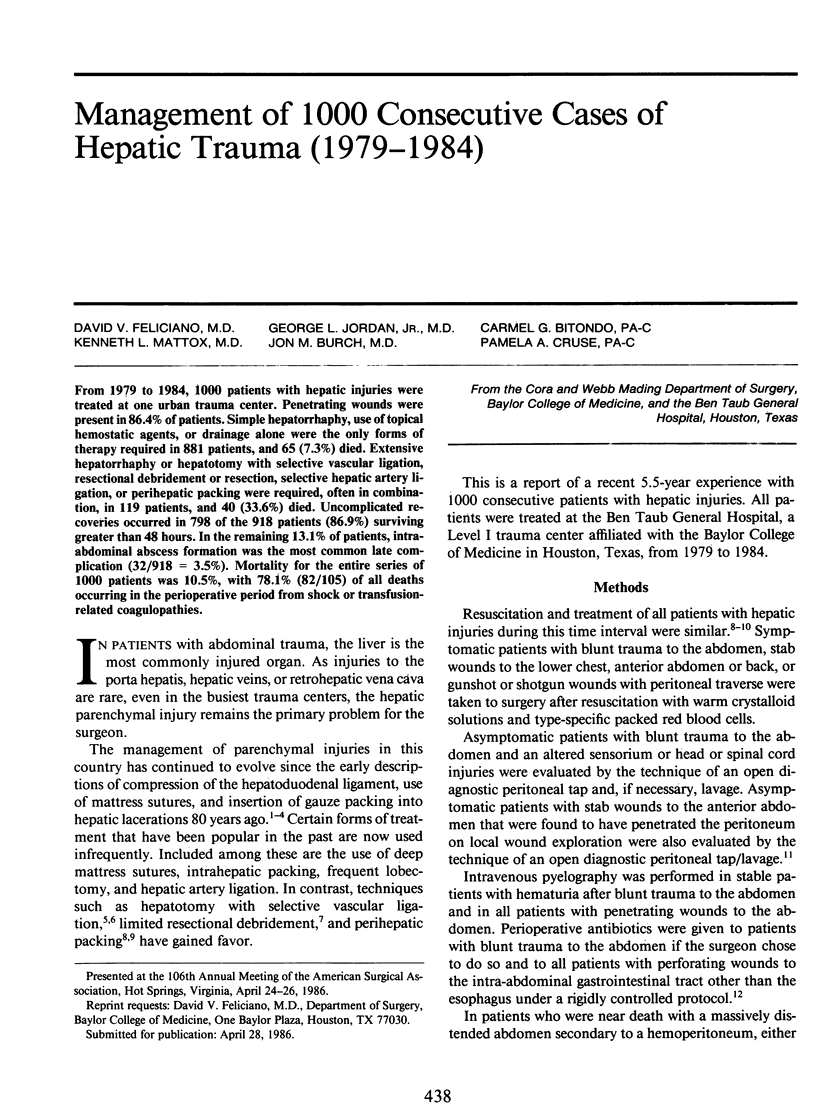
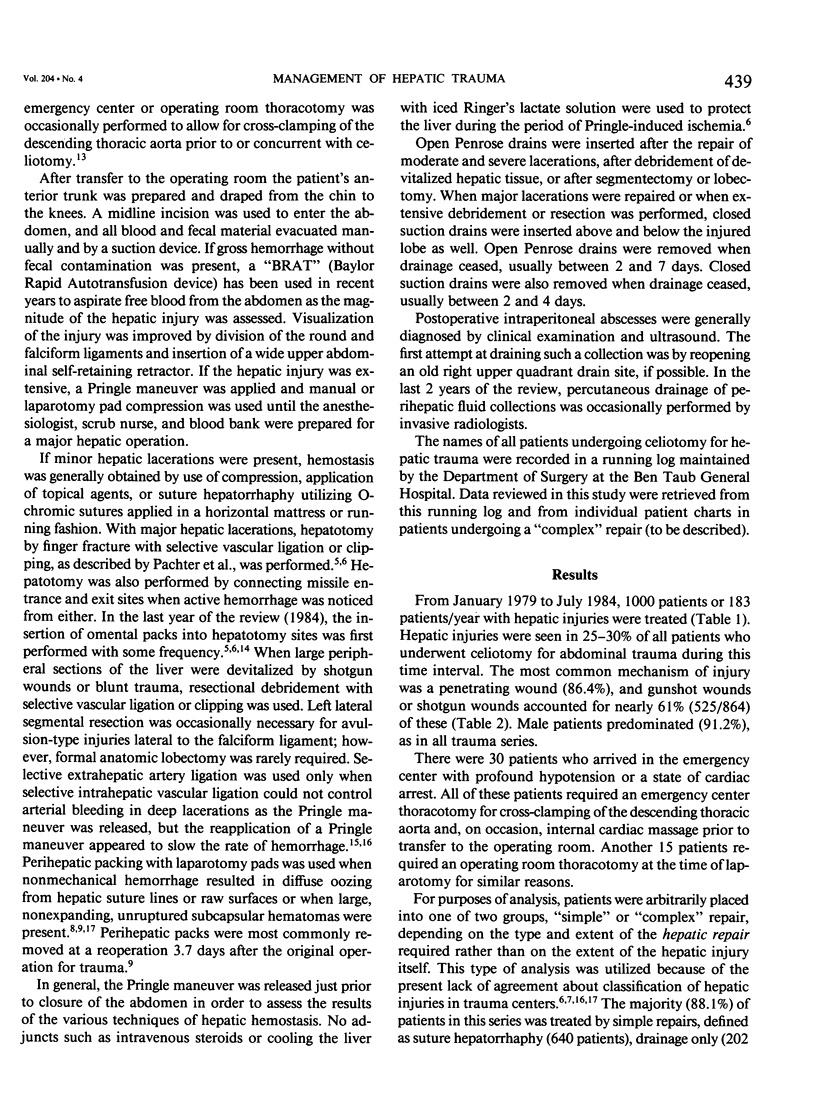
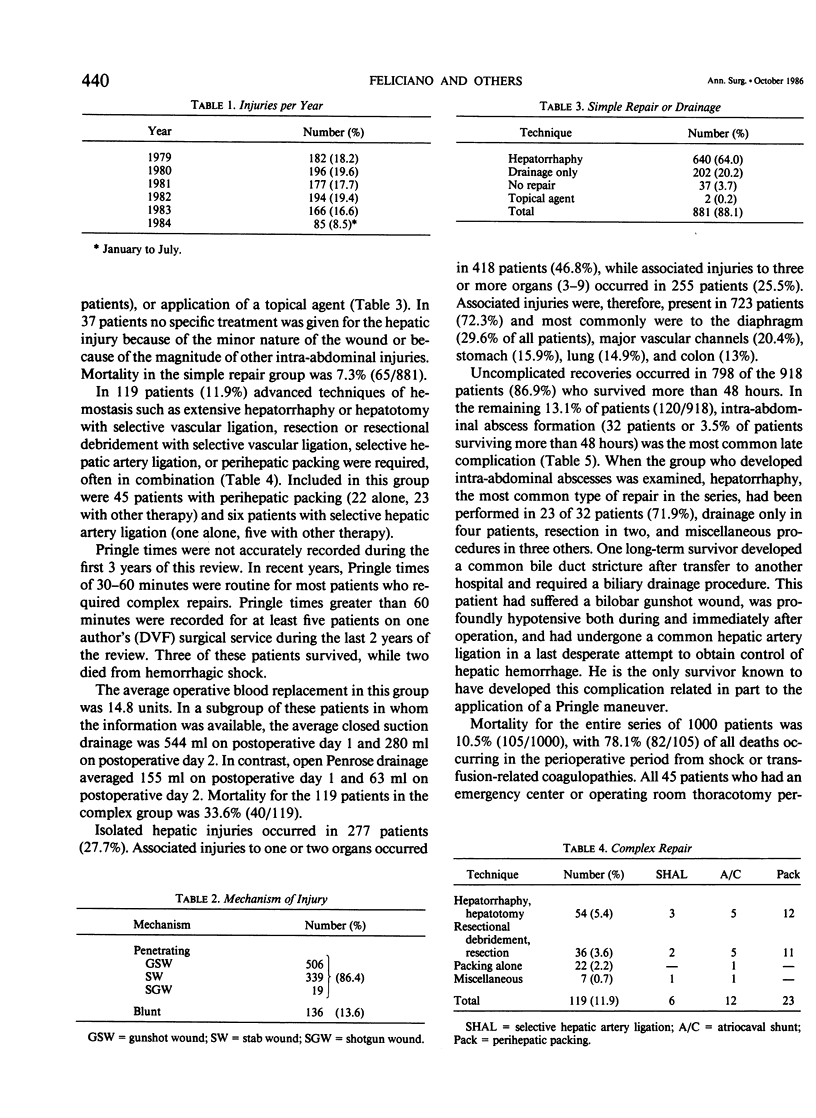
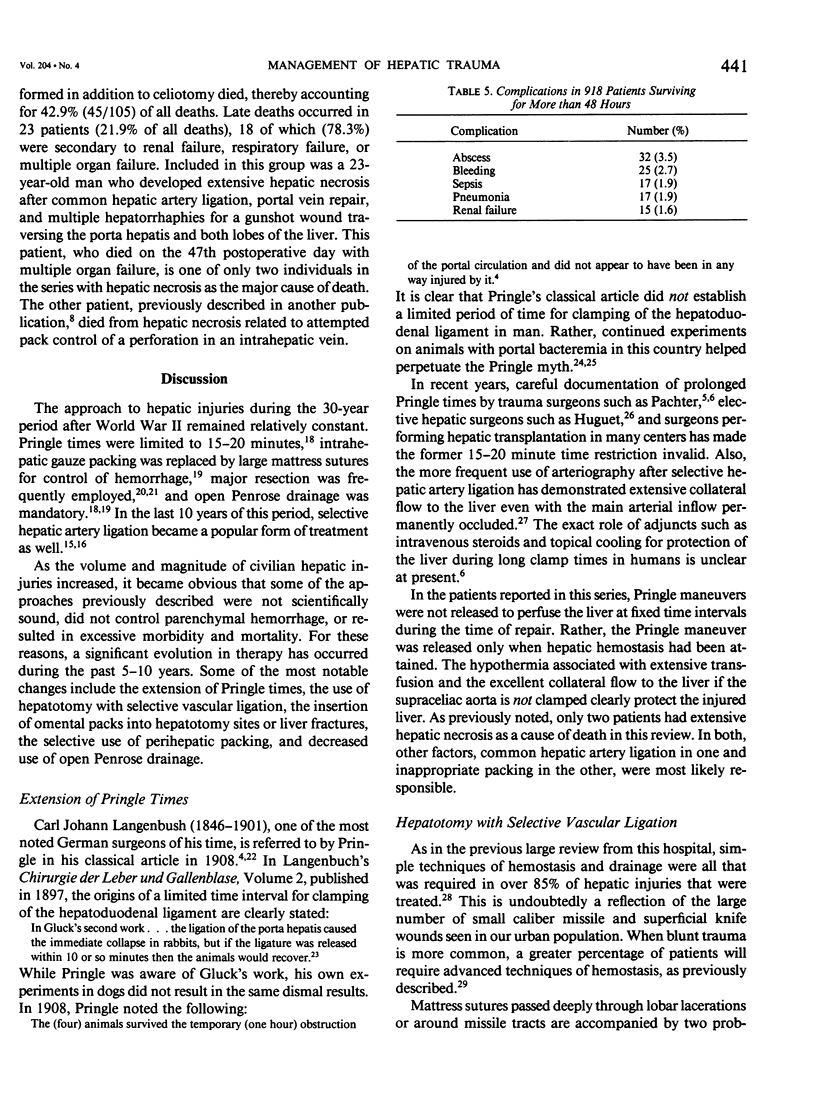
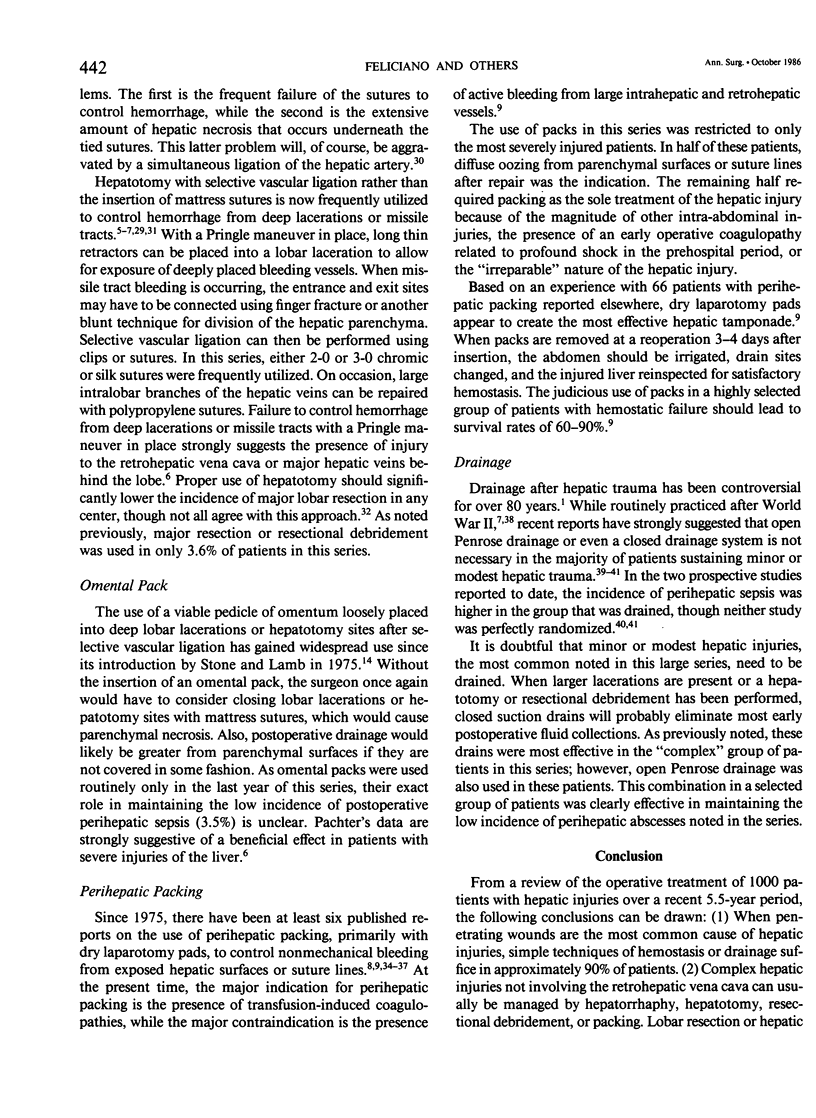
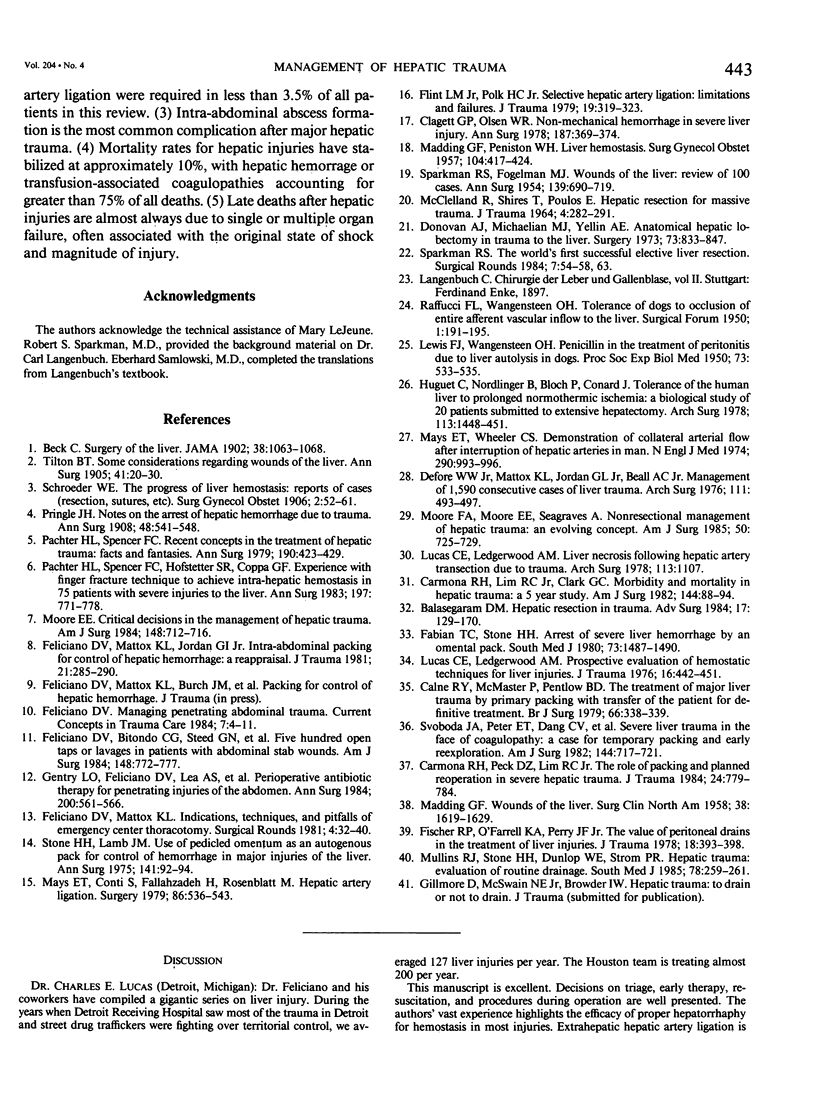
Selected References
These references are in PubMed. This may not be the complete list of references from this article.
- Balasegaram D. M. Hepatic resection in trauma. Adv Surg. 1984;17:129–170. [PubMed] [Google Scholar]
- Calne R. Y., McMaster P., Pentlow B. D. The treatment of major liver trauma by primary packing with transfer of the patient for definitive treatment. Br J Surg. 1979 May;66(5):338–339. doi: 10.1002/bjs.1800660512. [DOI] [PubMed] [Google Scholar]
- Carmona R. H., Lim R. C., Jr, Clark G. C. Morbidity and mortality in hepatic trauma. A 5 year study. Am J Surg. 1982 Jul;144(1):88–94. doi: 10.1016/0002-9610(82)90607-9. [DOI] [PubMed] [Google Scholar]
- Carmona R. H., Peck D. Z., Lim R. C., Jr The role of packing and planned reoperation in severe hepatic trauma. J Trauma. 1984 Sep;24(9):779–784. doi: 10.1097/00005373-198409000-00001. [DOI] [PubMed] [Google Scholar]
- Clagett G. P., Olsen W. R. Non-mechanical hemorrhage in severe liver injury. Ann Surg. 1978 Apr;187(4):369–374. doi: 10.1097/00000658-197804000-00004. [DOI] [PMC free article] [PubMed] [Google Scholar]
- Defore W. W., Jr, Mattox K. L., Jordan G. L., Jr, Beall A. C., Jr Management of 1,590 consecutive cases of liver trauma. Arch Surg. 1976 Apr;111(4):493–497. doi: 10.1001/archsurg.1976.01360220189033. [DOI] [PubMed] [Google Scholar]
- Fabian T. C., Stone H. H. Arrest of severe liver hemorrhage by an omental pack. South Med J. 1980 Nov;73(11):1487–1490. doi: 10.1097/00007611-198011000-00021. [DOI] [PubMed] [Google Scholar]
- Feliciano D. V., Bitondo C. G., Steed G., Mattox K. L., Burch J. M., Jordan G. L., Jr Five hundred open taps or lavages in patients with abdominal stab wounds. Am J Surg. 1984 Dec;148(6):772–777. doi: 10.1016/0002-9610(84)90435-5. [DOI] [PubMed] [Google Scholar]
- Feliciano D. V., Mattox K. L., Jordan G. L., Jr Intra-abdominal packing for control of hepatic hemorrhage: a reappraisal. J Trauma. 1981 Apr;21(4):285–290. doi: 10.1097/00005373-198104000-00005. [DOI] [PubMed] [Google Scholar]
- Fischer R. P., O'Farrell K. A., Perry J. F. The value of peritoneal drains in the treatment of liver injuries. J Trauma. 1978 Jun;18(6):393–398. doi: 10.1097/00005373-197806000-00003. [DOI] [PubMed] [Google Scholar]
- Flint L. M., Jr, Polk H. C., Jr Selective hepatic artery ligation: limitations and failures. J Trauma. 1979 May;19(5):319–323. doi: 10.1097/00005373-197905000-00003. [DOI] [PubMed] [Google Scholar]
- Gentry L. O., Feliciano D. V., Lea A. S., Short H. D., Mattox K. L., Jordan G. L., Jr Perioperative antibiotic therapy for penetrating injuries of the abdomen. Ann Surg. 1984 Nov;200(5):561–566. doi: 10.1097/00000658-198411000-00001. [DOI] [PMC free article] [PubMed] [Google Scholar]
- Huguet C., Nordlinger B., Bloch P., Conard J. Tolerance of the human liver to prolonged normothermic ischemia. A biological study of 20 patients submitted to extensive hepatectomy. Arch Surg. 1978 Dec;113(12):1448–1451. doi: 10.1001/archsurg.1978.01370240070012. [DOI] [PubMed] [Google Scholar]
- LEWIS F. J., WANGENSTEEN O. H. Penicillin in the treatment of peritonitis due to liver autolysis in dogs. Proc Soc Exp Biol Med. 1950 Apr;73(4):533–535. doi: 10.3181/00379727-73-17734. [DOI] [PubMed] [Google Scholar]
- Lucas C. E., Ledgerwood A. M. Liver necrosis following hepatic artery transection due to trauma. Arch Surg. 1978 Sep;113(9):1107–1107. doi: 10.1001/archsurg.1978.01370210089014. [DOI] [PubMed] [Google Scholar]
- Lucas C. E., Ledgerwood A. M. Prospective evaluation of hemostatic techniques for liver injuries. J Trauma. 1976 Jun;16(6):442–451. doi: 10.1097/00005373-197606000-00003. [DOI] [PubMed] [Google Scholar]
- MADDING G. F., PENISTON W. H. Liver hemostasis. Surg Gynecol Obstet. 1957 May;104(5):417–424. [PubMed] [Google Scholar]
- MADDING G. F. Wounds of the liver. Surg Clin North Am. 1958 Dec;38(6):1619–1629. doi: 10.1016/s0039-6109(16)35641-9. [DOI] [PubMed] [Google Scholar]
- MCCLELLAND R., SHIRES T., POULOS E. HEPATIC RESECTION FOR MASSIVE TRAUMA. J Trauma. 1964 May;4:282–291. doi: 10.1097/00005373-196405000-00002. [DOI] [PubMed] [Google Scholar]
- Mays E. T., Conti S., Fallahzadeh H., Rosenblatt M. Hepatic artery ligation. Surgery. 1979 Oct;86(4):536–543. [PubMed] [Google Scholar]
- Mays E. T., Wheeler C. S. Demonstration of collateral arterial flow after interruption of hepatic arteries in man. N Engl J Med. 1974 May 2;290(18):993–996. doi: 10.1056/NEJM197405022901804. [DOI] [PubMed] [Google Scholar]
- Moore E. E. Edgar J. Poth Lecture. Critical decisions in the management of hepatic trauma. Am J Surg. 1984 Dec;148(6):712–716. doi: 10.1016/0002-9610(84)90422-7. [DOI] [PubMed] [Google Scholar]
- Moore F. A., Moore E. E., Seagraves A. Nonresectional management of major hepatic trauma. An evolving concept. Am J Surg. 1985 Dec;150(6):725–729. doi: 10.1016/0002-9610(85)90417-9. [DOI] [PubMed] [Google Scholar]
- Mullins R. J., Stone H. H., Dunlop W. E., Strom P. R. Hepatic trauma: evaluation of routine drainage. South Med J. 1985 Mar;78(3):259–261. [PubMed] [Google Scholar]
- Pachter H. L., Spencer F. C., Hofstetter S. R., Coppa G. F. Experience with the finger fracture technique to achieve intra-hepatic hemostasis in 75 patients with severe injuries of the liver. Ann Surg. 1983 Jun;197(6):771–778. doi: 10.1097/00000658-198306000-00017. [DOI] [PMC free article] [PubMed] [Google Scholar]
- Pachter H. L., Spencer F. C. Recent concepts in the treatment of hepatic trauma: facts and fallacies. Ann Surg. 1979 Oct;190(4):423–429. doi: 10.1097/00000658-197910000-00001. [DOI] [PMC free article] [PubMed] [Google Scholar]
- Pringle J. H. V. Notes on the Arrest of Hepatic Hemorrhage Due to Trauma. Ann Surg. 1908 Oct;48(4):541–549. doi: 10.1097/00000658-190810000-00005. [DOI] [PMC free article] [PubMed] [Google Scholar]
- RAFFUCCI F. L., WANGENSTEEN O. H. Tolerance of dogs to occlusion of entire afferent vascular inflow to the liver. Surg Forum. 1950:191–195. [PubMed] [Google Scholar]
- SPARKMAN R. S., FOGELMAN M. J. Wounds of the liver; review of 100 cases. Ann Surg. 1954 May;139(5):690–719. doi: 10.1097/00000658-195405000-00018. [DOI] [PMC free article] [PubMed] [Google Scholar]
- Stone H. H., Lamb J. M. Use of pedicled omentum as an autogenous pack for control of hemorrhage in major injuries of the liver. Surg Gynecol Obstet. 1975 Jul;141(1):92–94. [PubMed] [Google Scholar]
- Svoboda J. A., Peter E. T., Dang C. V., Parks S. N., Ellyson J. H. Severe liver trauma in the face of coagulopathy. A case for temporary packing and early reexploration. Am J Surg. 1982 Dec;144(6):717–721. doi: 10.1016/0002-9610(82)90557-8. [DOI] [PubMed] [Google Scholar]
- Tilton B. T. II. Some Considerations regarding Wounds of the Liver. Ann Surg. 1905 Jan;41(1):20–30. doi: 10.1097/00000658-190501000-00003. [DOI] [PMC free article] [PubMed] [Google Scholar]


